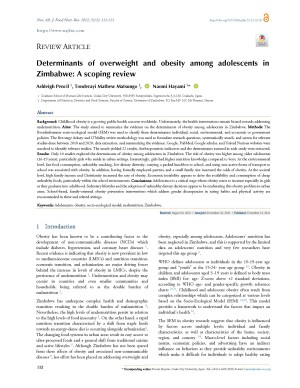Determinants of overweight and obesity among adolescents in Zimbabwe: A scoping review
Abstract
Background: Childhood obesity is a growing public health concern worldwide. Unfortunately, the health interventions remain biased towards addressing undernutrition. Aims: The study aimed to summarize the evidence on the determinants of obesity among adolescents in Zimbabwe. Methods: The Bronfenbrenner socio-ecological model (SEM) was used to classify these determinants: individual, social, environmental, and economic or government policies. The five-stage Arksey and O’Malley review methodology was used to formulate research questions, systematically search, and screen for relevant studies done between 2010 and 2020, data extraction, and summarizing the evidence. Google, PubMed, Google scholar, and United Nations websites were searched to identify relevant studies. The search yielded 22 results. Anthropometric indicators and the determinants assessed in each study were extracted. Results: Only 10 studies explored the determinants of obesity among adolescents in Zimbabwe. The risk of obesity was higher among older adolescents (16-19 years), particularly girls who reside in urban settings. Interestingly, girls had higher nutrition knowledge compared to boys. At the environmental level, fast food consumption, unhealthy snacking, low dietary diversity, carrying a packed lunchbox to school, and using non-active forms of transport to school was associated with obesity. In addition, having formally employed parents, and a small family size increased the odds of obesity. At the societal level, high family income and Christianity increased the rate of obesity. Economic instability appears to drive the availability and consumption of cheap unhealthy foods, particularly within the school environments. Conclusions: Adolescence is a critical stage where obesity starts to increase especially in girls as they graduate into adulthood. Sedentary lifestyles and the adoption of unhealthy dietary decisions appear to be exuberating this obesity problem in urban areas. School-based, family-oriented obesity prevention interventions which address gender discrepancies in eating habits and physical activity are recommended in these and related settings.
Full text article
Authors
Copyright (c) 2021 Authors

This work is licensed under a Creative Commons Attribution 4.0 International License.
-
Attribution — You must give appropriate credit, provide a link to the license, and indicate if changes were made. You may do so in any reasonable manner, but not in any way that suggests the licensor endorses you or your use.
-
No additional restrictions — You may not apply legal terms or technological measures that legally restrict others from doing anything the license permits.





